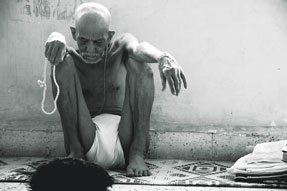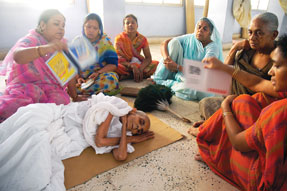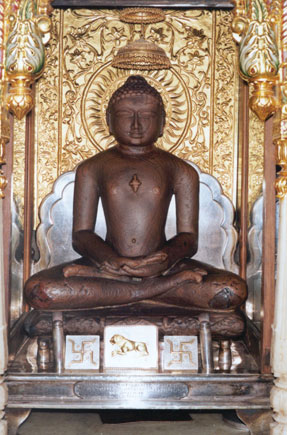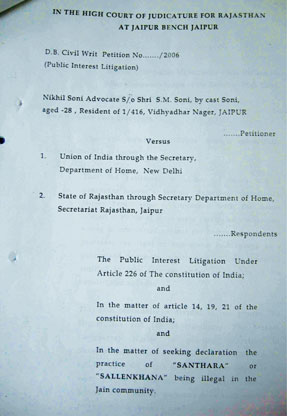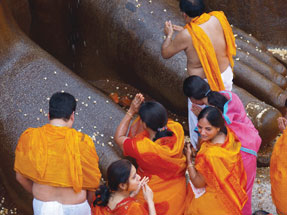Life
Freedom To Die

| Human rights activists in India are up in arms — metaphorically speaking — against a traditional Jain practice called Santhara (or Sallenkhana) in which a person starves to death voluntarily. Ever since Lord Mahaveer, the 24th and last Tirthankara, established the current tenets of Jainism in 400 B.C., thousands of his followers down the ages have taken their spiritual master’s cue and embraced this essential feature of Jain orthodoxy. The antiquity of the practice and its religious significance notwithstanding, Santhara has of late come within the cross-hairs of a campaign by activists to abolish the practice for its alleged abuses.
One such activist, Nikhil Soni, now a Jaipur-based lawyer, hails originally from the Churu district of the northwestern Indian state of Rajasthan. The district has acquired the dubious reputation of being the world’s Santhara capital for its highest per capita incidence of the practice in recent history. Growing up in Churu, Soni was for years a mute witness to several such ceremonial fasts-unto-death — till 2006.
That year, after failing to get the police to prevent Bimla Devi’s demise through Santhara, Soni filed a writ petition against the practice in the Rajasthan High Court. Calling it “a social evil” that should be deemed an act of “suicide” — and therefore illegal — under Indian law, his petition demands that practitioners of Santhara should be prosecuted under Section 309 of the Indian Penal Code for “attempt to commit suicide” and that their supporters — who encourage it by venerating them as “spiritually elevated” beings — charged with abetting a crime. The battle lines are clearly drawn. If Soni’s petition invokes the right to life enshrined in Article 21 of the Indian Constitution, the Santhara advocates posit its very corollary. The right to life, they argue, is meaningless without the corresponding right to stop living — i.e. the right to die. The same Article, they underline, also grants a person the right to personal liberty in such matters. Their defense — bolstered considerably by the active support of retired
High Court judge Pana Chand Jain — further seeks the protection of at least three other constitutional provisions, as well as the endorsement of an international covenant.
Articles 25 and 26 of India’s Constitution allow followers of all faiths to freely profess, practise and propagate their religious faith; and the freedom to manage their religious affairs. Mindful of the country’s ethnic and cultural diversity, Article 29 guarantees citizens with a distinct culture, the right to conserve the same. And Article 18 of the Universal Declaration of Human Rights — of which India is a signatory — says: “Everyone has the right to freedom of thought, conscience and religion; [and the right] to manifest his religion or belief in teaching, practice, worship and observance.” But all of the above collides head-on with the very citadel of India’s highest judiciary. If the Santhara followers have the country’s constitution and an international covenant apparently on their side, Nikhil Soni has the weight of judicial opinion firmly in his favor. After two judgments on the more controversial side of the “right-to-die” divide — notably Maruti Shripati Dubal v State of Maharashtra (1986) and P.Rathinam v Union of India (1994) which respectively held that “if destruction of one’s property or its deliverance to others for a cause or no cause is not an offence, there is no reason why sacrifice of one’s body for a cause or without a cause or for the mere deliverance of it should be regarded as an offence” and that Sec 309 of IPC was “unconstitutional and hence void” — a five-judge bench of the
Supreme Court ruled in Smt. Gian Kaur v State of Punjab (1996) that “the right-to-life is a natural right embodied in Article 21, but suicide is an unnatural termination or extinction of life and therefore incompatible and inconsistent with the concept of right-to-life.” Emphasizing the sanctity of human life, the Court, in over-ruling both Dubal and Rathinam, was categorical that “by no stretch of imagination” can “extinction” of life be read to be included in “protection” of life.
Should the Rajasthan High Court accept the Supreme Court’s precedent in Gian Kaur and outlaw Santhara, the decision would seriously dent the religious sensitivities of nearly six million practising Jains worldwide (25,000 to 75,000 of them in the USA — see sidebar), for whom the centuries-old ritual holds a pride of place among their sacred traditions. Its apologists — including Justice Jain — have already anticipated this eventuality and, in a clever attempt to pull the rug from under Soni’s petition, argue that Santhara cannot be characterized as “suicide” in the first place if only because, far from being an act of extreme desperation fuelled by anguish and hopelessness, a person relinquishing food and drink voluntarily by this method has arrived at that decision after calm introspection, with an intent to cleanse oneself of karmic encumbrances and thus attain the highest state of transcendental well-being. Santhara, for them, is therefore simply an act of spiritual purification premised on an exercise of individual autonomy. They point to an ecological dimension as well. Santhara practitioners reduce the burden that the rest of us eaters-and-drinkers routinely place on other life-forms in our environment, including plants. Devout Jains subscribe to a hierarchy of sorts on the amount of “bad” karma resulting from the consumption of certain foods. Thus, eating a single-seed fruit (like a mango) is less “sinful” than chomping on a multi-seed strawberry because of the latter’s natural potential to procreate several more “lives” in the flora. The same philosophy, sociologists point out, prompts Jains to shun vocations like farming — which cause “violence” to plant and micro-organic life in the soil — and to opt for relatively “non-violent” commercial pursuits, such as banking and trading in diamonds. Soni and his fellow-activists remain unimpressed by the nuances of this convoluted theological rationale. They are convinced that Santhara is, at best, suicide simpliciter masquerading as religious practice wrapped in the mantle of hoary tradition. At its worst, Santhara could well be nothing short of ritualized murder, devised to rid the family of the economic burden of taking care of its aged and unproductive members. Soni recalls the typical modus operandi exemplified in the Bimla Devi case. Diagnosed with terminal cancer, the elderly woman was too weak and depressed to protest as her relatives went about publicly announcing “her decision” to undertake Santhara. And, in her final hours, when Bimla Devi began screaming in a last-ditch effort to get food and water, her cries were drowned out by loud bhajans sung to the accompaniment of high-decibel percussion, he claims.
“If a person undertakes Santhara even on his or her own, the other members of the family are duty-bound to stop it,” asserts Madhav Mitra, counsel for Soni’s anti-Santhara petition, taking the argument further. “They just can’t let a suffering person die without painkillers or medical assistance. Even food and water are stopped. We consider this inhuman.”
The parallels with Sati are chilling. Most of the Santhara “volunteers” (or “victims” according to its opponents), it turns out, are women — elderly widows with relatives keen to celebrate their deaths. Says Sudhir Hirawat, grandson of another Santhara volunteer and a widow, Keila Devi Hirawat of Jaipur: “Our entire community is celebrating. This fasting is not to die, but a festival to face death. She is only cleansing her soul. This is our festival.” Adds Keila Devi’s daughter-in-law, Nirmala: “Everyone in the family is very happy. After all, she has brought name and fame to our family.” And how “voluntary” is their decision, when it is in fact taken and often persevered with under the threat of being socially ostracized if they entertain second thoughts? Going strictly by scripture, a Jain Stravak (lay person) cannot perform Santhara without the express permission of the dharma guru or religious head. How many of the 200-plus Santharas undertaken annually (according to media reports) have religious sanction is a matter of pure conjecture. For, it is well known that such permission is not easily forthcoming. While the Jain priesthood is quick to defend the practice in theory as an act of rational thinking and courage, and often bristles at its comparison with suicide, it is more cautious in the concept’s real-world application. The venerated Jain monk Vimal Sagarji Maharajsaheb concedes that there may be a very thin line between Santhara and suicide. “In certain instances, people have faced immense mental and physical tests [challenges] while observing Santhara and have not easily felt peace with themselves,” he admits. “So whether Santhara is suicide or a holy practice to attain moksha, I feel, is for the person embracing Santhara to answer for himself.”
What, the petitioners also ask, distinguishes Santhara legally from say, euthanasia (or mercy-killing) which, at present, stands afoul of Indian law? And why, one may pose in the same vein, are protestors on hunger-strike promptly arrested and force-fed, and additionally charged under Section 309 — as was done with Narmada Bachao Andolan activist Medha Patkar during her agitation against government policies over the rehabilitation of dam-displaced persons — while law-enforcers turn a passive, even indulgent, eye to the likes of quasi-spiritualist Acharya Vinoba Bhave, who refused food and medicine in his last days? Because Bhave had supported the Emergency imposed by the then Congress government? Or simply because he basked for most of his life in a Godman-Gandhian halo? Why this blatant discrimination?
It is perhaps the fear of exposing such double-standards in the polity as well as the apprehension of antagonizing a small but financially powerful Jain minority that explains the Court’s foot-dragging for over four years on the Soni petition. Writ petitions, by their very nature, tend to jump the line in court ahead of regular suits. Which is why jurists are astonished at the protracted course of the anti-Santhara petition. But with the Rajasthan state administration filing its final reply to the petition in September 2010 and the concluding court hearings scheduled for early 2011, Rajasthan’s additional advocate-general S.N. Kumawat expects that the case will be resolved soon — and in his favour. “The government’s stand, which is reflected in our reply, is simply that a long-established religious practice like Santhara cannot be called suicide, and that deeming it as such would create serious problems in a society like ours,” he warns darkly.
For the judiciary itself, there are other “internal” reasons why a clear-cut decision might cut uncomfortably close to the bone. Legitimizing Santhara would provide a backdoor entry to the pro-suicide lobby that so far was kept out of the debate by the Gian Kaur decision, and put a new question-mark over the embattled Section 309 of the IPC. Decreeing against the practice would, on the other hand, mean looking askance at some key articles of the Indian Constitution relating to religious autonomy.Either way, in ruling whether Santhara is indeed a legal means of terminating one’s life — and thus opining on whether an act sanctioned by religious belief can bypass the proscriptions of secular law — the Court will need to make a fine distinction between a bonafide “religious practice” that reflects and manifests a believer’s genuine and deeply felt inner longing, and a seemingly legitimate but pernicious and inhuman “social custom” that preys on the hapless and the marginalized.
Nikhil Soni v Union of India & Ors will undoubtedly be a landmark case. Not for the first time has an Indian court been called upon to decide between conflicting constitutional provisions concerning religion. In 1958, the Supreme Court in M.H.Qureshi & Ors v State of Bihar took on the issue of a ban on cow slaughter [Art 48] impinging on Muslim festivities during Bakr-Id [Arts 25, 26] and on the fundamental right of butchers to carry on their trade [Art 19(1)(g)]. But this time, the issue is decidedly more sensitive, and its consequences far more profound: it involves the extinguishment of a human life.
All the same, the court’s verdict on Santhara could have serious and long-term repercussions for similar beliefs in other religions practiced in India —specifically for the potentially inflammable issue of religious suicide. Witness this conundrum: Three members of a Muslim family recently died and ten others were hospitalized in a critical condition during a 40-day-fast at a 14th century Sufi saint’s dargah in Ajmer, Rajasthan. The fast was undertaken at the behest of a senior family-member who claimed he was acting under the “orders” of the saint who appeared in his dreams and prescribed the Chilla Kashi ritual to ward off black magic. Sufi scholars however are unanimous that Chilla Kashi calls for solitude and meditation during the stipulated period, but certainly not the kind of extreme abstinence and self-deprivation that puts its adherents in mortal danger.
The Ajmer tragedy — which attracted little public attention and no state intervention, such as police action — could perhaps be explained away as a stray instance of irrational misinterpretation of an imagined cult diktat. But, in these frenzied times of religious intolerance and knee-jerk opportunism, even the boldest judge would understandably be loath to open that Pandora’s box.
|

